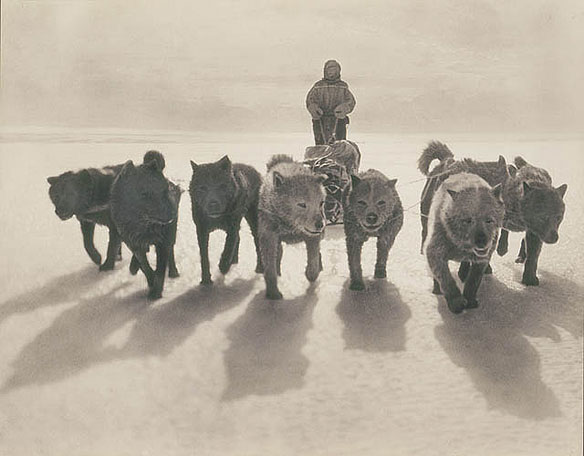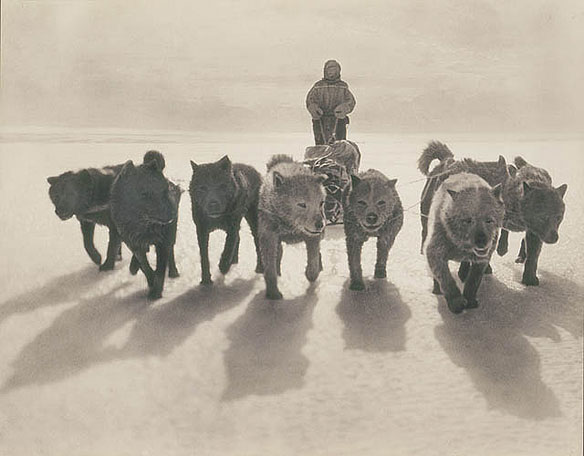
Huskies pulling sledge, 1911-1914. Photo source: State Library of New South Wales
By USGS
Personal interviews with Alaska Natives in the Yukon River Basin, provide unique insights on climate change and its impacts, helping develop adaptation strategies for these local communities.
The USGS coordinated interviews with Yup’ik hunters and elders in the villages of St. Mary’s and Pitka’s Point, Alaska, to document their observations of climate change. They expressed concerns ranging from safety, such as unpredictable weather patterns and dangerous ice conditions, to changes in plants and animals as well as decreased availability of firewood.
“Many climate change studies are conducted on a large scale, and there is a great deal of uncertainty regarding how climate change will impact specific regions,” said USGS social scientist Nicole Herman-Mercer. “This study helps address that uncertainty and really understand climate change as a socioeconomic issue by talking directly to those with traditional and personal environmental knowledge.”
By integrating scientific studies with indigenous observation, these multiple forms of knowledge allow for a more comprehensive understanding of the complex challenges posed by climate change. The indigenous knowledge encompasses observations, lessons and stories about the environment that have been handed down for generations, providing a long history of environmental knowledge. These observations can also help uncover new areas for scientists to study.
The Arctic and Subarctic are of particular interest because these high latitudes are among the world’s first locations to begin experiencing climate change.
The most common statement by interview participants was about warmer temperature in recent years. It was observed to be warmer in all seasons, though most notably in the winter months. In previous generations, winter temperatures dropped to 40 degrees Celsius below freezing, while in present times temperatures only reach 25 C or 30 C below freezing. Moreover, in the rare case that temperatures did drop as low as they had in the past, it was a brief cold spell, in contrast to historic month-long cold spells.
The considerable thinning of ice on the Yukon and Andreafsky Rivers in recent years was the topic of several interviews. Thin river ice is a significant issue because winter travel is mainly achieved by using the frozen rivers as a transportation route via snow machines or sled dogs. Thinning ice shortens the winter travel season, making it more difficult to trade goods between villages, visit friends and relatives, or reach traditional hunting grounds. One interview participant also discussed how the Andreafsky River, on whose banks their village lies, no longer freezes in certain spots, and several people have drowned after falling through the resulting holes in the ice.
The unpredictability of weather conditions was another issue of concern, especially since these communities rely on activities such as hunting, fishing and gathering wild foods for their way of life. One does not want to “get caught out in the country” when the weather suddenly changes.
Vegetation patterns were also observed to be shifting due to the changes in seasonal weather patterns, and this leads to increased difficulty in subsistence activities. Interviews showed the unpredictability from year to year on whether vegetation, particularly salmonberries, could be relied upon. Those interviewed spoke of a change in the range of species of mammals (moose and beaver) as well as a decrease in the number of some bird species (ptarmigan). This is of special concern because of the important role these animals play in the subsistence diets of Alaska Natives. Many also rely on hunting or trapping for their livelihoods.
Participants also discussed lower spring snowmelt flows on the Andreafsky and Yukon Rivers, meaning less logs are flowing down the river. This hampers people’s ability to collect logs for firewood and building materials, placing a strain on an already economically depressed region through increased heating costs and reliance on expensive fossil fuels.
An article on this topic was published in the journal, Human Organization. The full article with additional quotes and observations from indigenous people is available online Society For Applied Anthropology.
Global Climate Change: A Primer
This timely, informative book is exactly what the public needs to understand the ongoing disruption of the earth’s climate. Orrin H. and Keith C. Pilkey present an excellent summary of what we know, and what we don’t know, about the planet’s climate. They also provide a superb overview of a huge campaign underwritten by corporate dollars and intended to confuse the public and manufacture doubt about climate issues.









